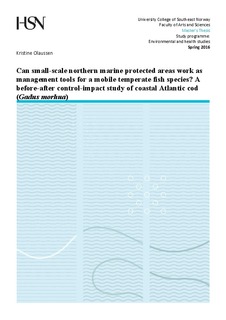| dc.contributor.author | Olaussen, Kristine | |
| dc.date.accessioned | 2016-11-02T12:49:35Z | |
| dc.date.accessioned | 2017-04-19T13:14:17Z | |
| dc.date.available | 2016-11-02T12:49:35Z | |
| dc.date.available | 2017-04-19T13:14:17Z | |
| dc.date.issued | 2016 | |
| dc.identifier.citation | Olaussen, K. Can small-scale northern marine protected areas work as management tools for a mobile temperate fish species? A before-after control-impact study of coastal Atlantic cod (Gadus morhua). Master thesis, University College of Southeast Norway, 2016 | |
| dc.identifier.uri | http://hdl.handle.net/11250/2438978 | |
| dc.description.abstract | The recruitment and spawning stock biomass of Atlantic cod (Gadus morhua) along the Skagerrak coast have been extremely low the last years and overfishing seems to be one of the main factors for this decrease. Marine protected areas may promote recovery of exploited populations within their boundaries and have received increasingly attention as fisheries and conservation tools. However, few studies are conducted in temperate areas and there is a lack of information form before MPA establishment in many studies, which will limit the interpretation of the results. In this study, we investigated MPA effects on cod using a before-after control-impact (BACI) approach. When protecting a portion of an exploited stock, it is expected that density of targeted species within protected areas will increase. Significantly higher mean size/age, and significantly higher production of propagules of target species are also major expectations. Therefore, body size and cod density was measured in three partly protected areas and one no-take reserve implemented in the municipality of Tvedestrand in 2012. We also collected data from control areas with varying distances from the MPAs. By 2015, cod inside the no-take reserve and two of the partly protected areas was on average 10 cm longer than in any of the control areas. An increase in cod density (measured in catch per unit effort (CPUE)) inside the MPAs compared to controls, was only significant in one of the partly protected areas. Potential causes for these differences are discussed in the thesis. For Marine protected areas to work as a management tool they should in the long term compensate for the loss of fishing area. If they not fully compensates for this loss, they will still act as a reserve of spawning stock from which to start a recovery. After three years of protection, the effects of protection on cod populations are not clear and it is highly recommended to continue this research as the signs of recovery may take years to observe. | |
| dc.language.iso | eng | |
| dc.publisher | Høgskolen i Sørøst-Norge | |
| dc.subject | Atlantic cod | |
| dc.subject | spawning | |
| dc.subject | marine protection areas | |
| dc.title | Can small-scale northern marine protected areas work as management tools for a mobile temperate fish species? A before-after control-impact study of coastal Atlantic cod (Gadus morhua) | |
| dc.type | Master thesis | |
| dc.description.version | Published version | |
| dc.rights.holder | © Copyright The Author. All rights reserved | |
| dc.subject.nsi | 488 | |
| dc.subject.nsi | 497 | |
